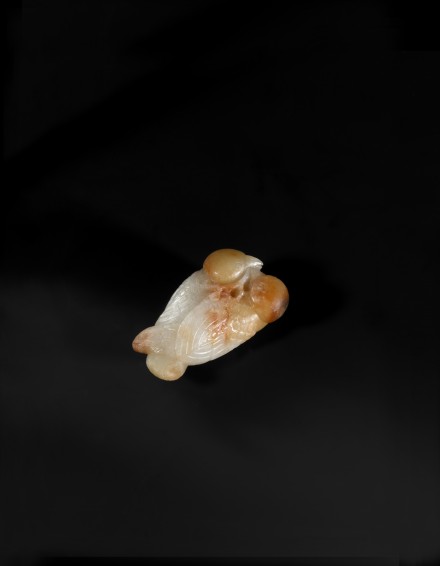J.J. Lally & Co., Oriental Art / New York City, New York
MenuPast Exhibition
ELEGANTLY MADE: Art for the Chinese Literati
March 13-27, 2020

29.
A JADE CARVING OF A PAIR OF MAGPIES
Qianlong Period (1736-1795)
the two plump birds compactly carved side by side with wings folded and tails together, holding sprigs of blossoming plum in their beaks, the branches entwined and pierced at the underside to form a natural loop for suspension, fully detailed all over, the silvery-white jade with bright russet markings well used in the carving.
Length 2 3⁄4 inches (7 cm)
Provenance
Bluett & Sons Ltd., London, 1963
From the Collection of Roger Pilkington (1928-1969), Lancashire, England
Sotheby’s Hong Kong, The Pilkington Collection of Chinese Art, 6 April 2016, lot 58
In Chinese tradition, the magpie (喜鵲, xique) is a bird of happiness (喜, xi), a messenger bringing good news, while the blossoming plum (梅, mei) signifies the arrival of Spring. Together they represent a blissful joy shown through one’s eyes (喜上眉梢, xi shang mei shao). A pair of magpies with prunus also represents fidelity and marital harmony, wishing the couple a lifetime of happiness together.
A very similar jade carving of a pair of magpies in the Palace Museum, Beijing, from the Qing Court Collection, is illustrated in Gugong bowuyuan cang wenwu zhenpin quanji (The Complete Collection of Treasures of the Palace Museum), Vol. 42, Jadeware (III), Hong Kong, 1995, p. 102, no. 82.
清乾隆 褐斑白玉「喜上眉梢」雙鵲 長 7 厘米
來源 倫敦 Bluett & Sons Ltd.,1963
英國蘭開夏郡 Roger Pilkington (1928-1969) 舊藏
香港蘇富比 2016 年 4 月 6 日,拍品第 58 號
29.
A JADE CARVING OF A PAIR OF MAGPIES
Qianlong Period (1736-1795)
Length 2 3⁄4 inches (7 cm)